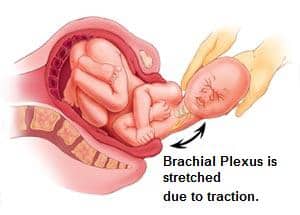
Erb’s Palsy, sometimes known as Erb-Duchenne Palsy, is a stretch injury that typically occurs at birth and causes weakness or paralysis in a baby’s arm. In many cases, treatment involves surgery and, in some cases, the injury leads to life-long and functional issues. The stretch injury that involves the brachial plexus and leads to Erb’s […]
 Erb’s Palsy, sometimes known as Erb-Duchenne Palsy, is a stretch injury that typically occurs at birth and causes weakness or paralysis in a baby’s arm. In many cases, treatment involves surgery and, in some cases, the injury leads to life-long and functional issues.
Erb’s Palsy, sometimes known as Erb-Duchenne Palsy, is a stretch injury that typically occurs at birth and causes weakness or paralysis in a baby’s arm. In many cases, treatment involves surgery and, in some cases, the injury leads to life-long and functional issues.
The stretch injury that involves the brachial plexus and leads to Erb’s Palsy involves the nerves near the neck that branch out to the arm’s nerves. The nerves enable movement, as well as feeling, to the arm, hand, and fingers.
Stretch injuries typically happen during birth when the baby’s shoulder become stuck on the mother’s pelvic bone, a condition known as shoulder dystocia. When this occurs, the physician must perform a specific maneuver to avoid creating pressure on the shoulder. If done incorrectly, the nerve tissue may be stretched, torn, or ruptured. Obstetricians are trained to recognize the signs of shoulder dystocia and to appropriately manage the birthing situation to ensure a safe delivery.
Although Erb’s Palsy may be result from seemingly normal births, there are a number of signs that provide opportunities for a physician to prevent the injuries that lead to Erb’s palsy including a higher birth weight of more than 8 pounds, 14 ounces; a pregnancy that goes beyond 40 weeks; a mother who is heavy, short, who has a contracted or flat pelvis, or who has been diagnosed with maternal diabetes; or a protracted second stage of labor. The need for a quick delivery in which force must be exerted, or the use of forceps, vacuums, specific medications, or other tools may also be factors.
In many cases, Erb’s Palsy may have been preventable and, when Erb’s Palsy is a possible delivery complication, physicians may use other procedures to maneuver the baby’s shoulder to ensure a safe passage through the birthing canal, such as repositioning the mother or changing the baby’s position. In very dangerous situations, the doctor may perform an emergency C-section or may intentionally break the baby’s clavicle bone or the mother’s pelvic bone to avoid an Erb’s Palsy injury.
When too much force is exerted or doctors wait too long to perform a necessary C-section, the baby may suffer unnecessary injuries, including Erb’s Palsy.
Erb’s Palsy treatment may take many months, may involve surgery, and may not always restore full use of the arm and fingers, leaving the child with significant, life-long damage that adversely hampers arm and/or hand use. In some cases, there is no recovery when an avulsion or rupture injury occurs and if Erb’s Palsy surgery to attempt nerve reconnection is not done. Sometimes, even with Erb’s Palsy surgery, many children will still have weakness in the shoulder, arm, or hand. In some cases, surgical procedures may be performed at a later date, including muscle and tendon transfer surgery to improve function, or joint fusion surgery.
Erb’s Palsy Brachial Plexus Injuries may involve full avulsion of the nerve from the spine, the most severe Erb’s Palsy injury, which is not always fully reversible. Other cases involve rupture, in which the nerve is torn, but not at the area of spinal attachment; neuroma, which involves a tear that healed, forming scar tissue that presses on the injured nerve; or neuropraxia, which involves damage, but not a tear, to the nerve. Erb’s Palsy injuries may impair the baby’s ability to move the arm or shoulder; cause the baby’s arm to bend in, toward the body; may leave the arm weak, with no reflex responses or with loss of muscle control in the arm, hand, or wrist; or may leave the arm limp or paralyzed. Children with Erb’s Palsy are typically treated by an orthopedic surgeon and a neurologist.


